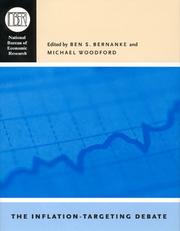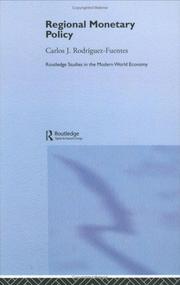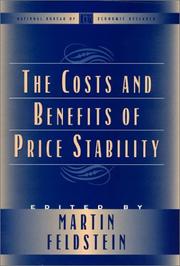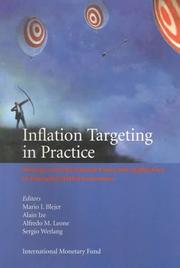| Listing 1 - 10 of 11 | << page >> |
Sort by
|
Book
ISBN: 3319893564 9783319893563 3319893572 Year: 2018 Publisher: Cham : Springer International Publishing : Imprint: Palgrave Macmillan,
Abstract | Keywords | Export | Availability | Bookmark
 Loading...
Loading...Choose an application
- Reference Manager
- EndNote
- RefWorks (Direct export to RefWorks)
This book analyses the controversial and critical issue of 2% inflation targeting, currently practised by central banks in the US, Japan and Europe. Where did the 2% target inflation originate, and for what reason? Do these reasons stand up to scrutiny? This book explores these key questions, contributing to the growing debate that the global 2% inflation standard prescribed by the central banks in the advanced economies globally is actually contributing to the economic malaise of these nations. It presents novel theoretical perspectives, intertwined with historical and market understanding, and features analysis that draws on monetary theory (including Austrian school), behavioural finance, and finance theory. Alongside rigorous analysis of the past and present, the book also features forward looking chapters, exploring how the 2% global inflation standard could collapse and what would ideally follow its demise, including a new look at the role of gold.
333.846.2 --- Verband tussen de geld-, bank- en kredietpolitiek en de prijzen --- Inflation (Finance) --- Interest rates. --- Money market rates --- Rate of interest --- Rates, Interest --- Interest --- Finance --- Natural rate of unemployment --- Finance. --- Macroeconomics. --- Popular Science in Finance. --- Macroeconomics/Monetary Economics//Financial Economics. --- Economics --- Funding --- Funds --- Currency question
Book
ISBN: 9780511605475 9780521848503 9781107514119 0521848504 9780511605178 051160517X 1107195829 1107514118 1282317954 9786612317958 0511604556 0511603770 0511604874 0511602995 0511605471 Year: 2009 Publisher: New York : Cambridge University Press,
Abstract | Keywords | Export | Availability | Bookmark
 Loading...
Loading...Choose an application
- Reference Manager
- EndNote
- RefWorks (Direct export to RefWorks)
All central banks manage the supply of money and credit in their countries, increasing and decreasing them as needed to provide what economies need to keep growing. The way central banks typically handle that job involves short-term interest rates. But when inflation is low, central banks can't use their usual methods to get money and credit into an economy that needs it. Several essays in this volume describe the work of economists who have investigated problems that central banks might have when inflation gets low. Other essays investigate related questions such as whether an economy suffers when it moves from high inflation to low inflation, what the costs of inflation are to economic welfare, and whether a little bit of inflation can actually be good for economic growth.
Inflation (Finance) --- Monetary policy --- 339.53 --- 333.841 --- 333.846.2 --- AA / International- internationaal --- Monetary management --- Economic policy --- Currency boards --- Money supply --- Finance --- Natural rate of unemployment --- Inflatie --- Verband tussen de geld-, bank- en kredietpolitiek en de prijzen --- Monetary policy. --- Business, Economy and Management --- Economics
Book
ISBN: 9780521768184 9786612770722 9780511901430 0521768187 9780511779770 9781107696891 1107713447 1107209218 1282770721 0511901437 0511902220 0511799071 0511797672 0511779771 0511900643 9780511902222 1107696895 Year: 2010 Publisher: New York : Cambridge University Press,
Abstract | Keywords | Export | Availability | Bookmark
 Loading...
Loading...Choose an application
- Reference Manager
- EndNote
- RefWorks (Direct export to RefWorks)
There is now a remarkably strong consensus among academics and professional economists that central banks should adopt explicit inflation targets and that all key monetary policy decisions, especially those concerning interest rates, should be made with a view to ensuring that these targets are achieved. This book provides a comprehensive review of the experience of inflation targeting since its introduction in New Zealand in 1989 and looks in detail at what we can learn from the past twenty years and what challenges we may face in the future. Written by a distinguished team of academics and professional economists from central banks around the world, the book covers a wide range of issues including many that have arisen as a result of the recent financial crisis. It should be read by anyone concerned with better understanding inflation targeting and its past, present and future role within monetary policy.
Banks and banking, Central --- Inflation targeting --- AA / International- internationaal --- 333.841 --- 333.846.2 --- Inflatie. --- Verband tussen de geld-, bank- en kredietpolitiek en de prijzen. --- Inflation (Finance) --- -Monetary policy --- -Banks and banking, Central --- -339.530993 --- Banker's banks --- Banks, Central --- Central banking --- Central banks --- Banks and banking --- Monetary management --- Economic policy --- Currency boards --- Money supply --- Finance --- Natural rate of unemployment --- Electronic information resources --- E-books --- Targeting, Inflation --- Monetary policy --- Inflatie --- Verband tussen de geld-, bank- en kredietpolitiek en de prijzen --- Inflation targeting. --- Monetary policy. --- Banks and banking, Central. --- Business, Economy and Management --- Economics

ISBN: 0226044718 9786611125318 1281125318 0226044734 9780226044736 9780226044712 9780226044729 0226044726 Year: 2005 Publisher: Chicago : University of Chicago Press,
Abstract | Keywords | Export | Availability | Bookmark
 Loading...
Loading...Choose an application
- Reference Manager
- EndNote
- RefWorks (Direct export to RefWorks)
Over the past fifteen years, a significant number of industrialized and middle-income countries have adopted inflation targeting as a framework for monetary policymaking. As the name suggests, in such inflation-targeting regimes, the central bank is responsible for achieving a publicly announced target for the inflation rate. While the objective of controlling inflation enjoys wide support among both academic experts and policymakers, and while the countries that have followed this model have generally experienced good macroeconomic outcomes, many important questions about inflation targeting remain. In Inflation Targeting, a distinguished group of contributors explores the many underexamined dimensions of inflation targeting-its potential, its successes, and its limitations-from both a theoretical and an empirical standpoint, and for both developed and emerging economies. The volume opens with a discussion of the optimal formulation of inflation-targeting policy and continues with a debate about the desirability of such a model for the United States. The concluding chapters discuss the special problems of inflation targeting in emerging markets, including the Czech Republic, Poland, and Hungary.
Inflation targeting --- Inflation (Finance) - Congresses. --- Monetary policy - Congresses. --- -332.41 --- Inflation (Finance) --- Monetary policy --- E-books --- 332.41 --- 333.80 --- 333.846.2 --- AA / International- internationaal --- Targeting, Inflation --- Geld-, bank- en kredietpolitiek. Kapitaalmarkt en -rente: algemeenheden --- Verband tussen de geld-, bank- en kredietpolitiek en de prijzen --- Conferences - Meetings --- Electronic books. --- Inflation (Finance). --- Congresses. --- inflation, economics, monetary policy, macroeconomics, emerging markets, hungary, poland, czech republic, central banks, chile, constraint, equilibrium, emu, exchange rates, federal reserve, greenspan, growth, output, fiscal policies, nonfiction, imperfect knowledge, israel, japan, price, stability, sweden, switzerland, targeting, transparency, variables, wages.
Book
ISBN: 9780691145402 0691145407 1299688063 1400846447 9781400846443 9781299688063 Year: 2013 Publisher: Princeton, N.J. : Princeton University Press,
Abstract | Keywords | Export | Availability | Bookmark
 Loading...
Loading...Choose an application
- Reference Manager
- EndNote
- RefWorks (Direct export to RefWorks)
Today's global economy, with most developed nations experiencing very low inflation, seems a world apart from the "Great Inflation" that spanned the late 1960's to early 1980's. Yet, in this book, Brigitte Granville makes the case that monetary economists and policymakers need to keep the lessons learned during that period very much in mind, lest we return to them by making the same mistakes we made in the past. Granville details the advances in macroeconomic thinking that gave rise to the "Great Moderation"--a period of stable inflation and economic growth, which lasted from the mid-1980's through the most recent financial crisis. She makes the case that the central banks' management of monetary policy--hinging on expectations and credibility--brought about this period of stability, and traces the roots of this success back to the eighteenth-century foundations of modern monetary thought. Tackling fundamental questions such as the causes of inflation and its relation to unemployment and growth, the natural rate of inflation hypothesis, the fiscal theory of the price level, and the proper goals of central banks, the book aims above all to demonstrate the dangers of forgetting the role of credibility in establishing sound monetary policy. With the lessons of the past firmly in mind, Granville presents stimulating ideas and proposals about inflation-targeting principles, which provide tools for present-day monetary authorities dealing with the forces of globalization, mercantilism, and reserve accumulation.
Money. Monetary policy --- Inflation (finance) --- Monetary policy --- Inflation (Finance) --- 333.841 --- 333.846.2 --- AA / International- internationaal --- 332 --- Monetary management --- Economic policy --- Currency boards --- Money supply --- Finance --- Natural rate of unemployment --- Inflatie. --- Verband tussen de geld-, bank- en kredietpolitiek en de prijzen. --- Business & Economics --- Money --- Monetary policy. --- E-books --- Inflatie --- Verband tussen de geld-, bank- en kredietpolitiek en de prijzen --- Brazil. --- Great Moderation. --- Russia. --- Sargent and Wallace. --- capacity utilization. --- central bank. --- competition. --- economic growth. --- economic theory. --- economists. --- euro. --- exchange rate. --- external rule. --- financial crisis. --- financial integration. --- financial stability. --- fiscal policy. --- global economy. --- globalization. --- income inequality. --- inflation control. --- inflation. --- international trade. --- macroeconomic policy. --- macroeconomics. --- monetary policy. --- monetary stability. --- monetary thought. --- poverty. --- price level. --- price stability. --- public debt. --- recession. --- social welfare. --- solvency. --- stable inflation. --- unemployment. --- world economy.
Book
ISBN: 9780262013635 0262013630 9786612694462 0262258781 1282694464 026225820X 9780262258784 6612694467 9781282694460 Year: 2009 Publisher: Cambridge, Mass. : MIT Press,
Abstract | Keywords | Export | Availability | Bookmark
 Loading...
Loading...Choose an application
- Reference Manager
- EndNote
- RefWorks (Direct export to RefWorks)
The 'Phillips curve' represents the inverse relationship between inflation & unemployment, & is a central concept in macroeconomic analysis. This volume offers an assessment of how more sophisticated analysis of prices & wage setting & inflation expectations have changed the nature of the curve.
Inflation (Finance) --- Phillips curve --- Monetary policy --- Unemployment --- Effect of inflation on --- Mathematical models --- AA / International- internationaal --- 333.841 --- 333.846.2 --- -Phillips curve --- -Monetary policy --- -Unemployment --- -332.41 --- Monetary management --- Economic policy --- Currency boards --- Money supply --- Joblessness --- Employment (Economic theory) --- Full employment policies --- Labor supply --- Manpower policy --- Right to labor --- Underemployment --- Inflatie. --- Verband tussen de geld-, bank- en kredietpolitiek en de prijzen. --- -Mathematical models --- Electronic books. -- local. --- Inflation (Finance) -- Congresses. --- Monetary policy -- Congresses. --- Phillips curve -- Congresses. --- Unemployment -- Effect of inflation on -- Mathematical models -- Congresses. --- Money --- Finance --- Business & Economics --- -Electronic books. -- local. --- ECONOMICS/Macroeconomics --- 332.41 --- Inflatie --- Verband tussen de geld-, bank- en kredietpolitiek en de prijzen --- Inflation (Finance) - Congresses --- Phillips curve - Congresses --- Monetary policy - Congresses --- Unemployment - Effect of inflation on - Mathematical models - Congresses

ISBN: 0415327636 1280290161 9786610290161 020302219X 0415651417 1134336950 1134336942 Year: 2006 Publisher: New York, N.Y. : Routledge,
Abstract | Keywords | Export | Availability | Bookmark
 Loading...
Loading...Choose an application
- Reference Manager
- EndNote
- RefWorks (Direct export to RefWorks)
With the final phase of the European Monetary Union underway, concern has been raised over the regional implications of the European Central Bank (ECB) Monetary Policy. Departing from the standard approach utilized by the ECB, this book provides a comprehensive theoretical framework to explore the ways through which money and monetary policy may affect regions.Carlos Rodriguez Fuentes, the rising star of Spanish economics, has produced a work of impressive clarity which analyzes the effects of regional monetary policy - with particular reference to European Monetary Union. Her
AA / International- internationaal --- 333.80 --- 333.846.2 --- Geld-, bank- en kredietpolitiek. Kapitaalmarkt en -rente: algemeenheden. --- Verband tussen de geld-, bank- en kredietpolitiek en de prijzen. --- Espanja --- Spanien --- Hiszpania --- Spanish State --- Estado Español --- Hispania --- Sefarad --- Sepharad --- Shpanye --- Shpanie --- Reino de España --- Kingdom of Spain --- Monetary policy. --- Regional economics. --- Monetary management --- Spain --- España --- Espagne --- Reino d'Espanya --- Reinu d'España --- Espainiako Erresuma --- Regne d'Espanya --- Reiaume d'Espanha --- Espanya --- Espanha --- スペイン --- Supein --- イスパニア --- Isupania --- Economic conditions --- Economics --- Regional planning --- Regionalism --- Space in economics --- Economic policy --- Currency boards --- Money supply --- Monetary policy --- Regional economics --- Geld-, bank- en kredietpolitiek. Kapitaalmarkt en -rente: algemeenheden --- Verband tussen de geld-, bank- en kredietpolitiek en de prijzen --- E-books --- liquidity --- preference --- shocks --- money --- supply --- national --- endogenous --- central --- bank --- interest

ISBN: 0226240991 9786611223373 1281223379 0226241769 9780226241760 9780226240992 9781281223371 6611223371 Year: 1999 Publisher: Chicago : University of Chicago Press,
Abstract | Keywords | Export | Availability | Bookmark
 Loading...
Loading...Choose an application
- Reference Manager
- EndNote
- RefWorks (Direct export to RefWorks)
In recent years, the Federal Reserve and central banks worldwide have enjoyed remarkable success in their battle against inflation. The challenge now confronting the Fed and its counterparts is how to proceed in this newly benign economic environment: Should monetary policy seek to maintain a rate of low-level inflation or eliminate inflation altogether in an effort to attain full price stability? In a seminal article published in 1997, Martin Feldstein developed a framework for calculating the gains in economic welfare that might result from a move from a low level of inflation to full price stability. The present volume extends that analysis, focusing on the likely costs and benefits of achieving price stability not only in the United States, but in Germany, Spain, and the United Kingdom as well. The results show that even small changes in already low inflation rates can have a substantial impact on the economic performance of different countries, and that variations in national tax rules can affect the level of gain from disinflation.
Economic policy and planning (general) --- Prices --- Monetary policy --- Inflation (Finance) --- Price regulation --- Congresses --- Government policy --- politique economique --- politique des prix --- inflation --- impot sur le capital --- politique fiscale --- international --- AA / International- internationaal --- DE / Germany - Duitsland - Allemagne --- ES / Spain - Spanje - Espagne --- GB / United Kingdom - Verenigd Koninkrijk - Royaume Uni --- US / United States of America - USA - Verenigde Staten - Etats Unis --- 333.841 --- 380.3 --- 333.846.2 --- NBB congres --- -Price regulation --- -Monetary policy --- -Inflation (Finance) --- -338.526 --- Monetary management --- Economic policy --- Currency boards --- Money supply --- Government price control --- Government price regulation --- Price control --- Price stabilization, Governmental --- Pricing --- Regulation of prices --- Trade regulation --- Anti-inflationary policies --- Commercial products --- Commodity prices --- Justum pretium --- Price theory --- Consumption (Economics) --- Cost --- Costs, Industrial --- Money --- Cost and standard of living --- Supply and demand --- Value --- Wages --- Willingness to pay --- economisch beleid --- prijsbeleid --- inflatie --- vermogensbelasting --- fiscaal beleid --- internationaal --- Inflatie. --- Prijsbeleid. --- Verband tussen de geld-, bank- en kredietpolitiek en de prijzen. --- -Law and legislation --- Law and legislation --- Congresses. --- -politique economique --- Government policy&delete& --- Precios --- Política y gobierno --- Congresos, conferencias, etc. --- Regulación de los precios --- Inflacción (Finanzas) --- Política monetaria --- E-books --- 338.526 --- Inflatie --- Verband tussen de geld-, bank- en kredietpolitiek en de prijzen --- Prijsbeleid --- Inflation (finance) --- Monetary policy - Congresses --- Inflation (Finance) - Congresses --- Price regulation - Congresses --- Prices - Government policy - Congresses --- federal reserve, bank, banking, banker, international, global, inflation, fed, economic, economy, economics, price, low level, rate, article, 1990s, contemporary, modern, 20th century, gains, welfare, united states, germany, spain, uk, america, tax, taxes, capital, income, cost, benefit, analysis, essay collection, textbook, academic, scholarly, research, college, university.

ISBN: 1557758891 1462368387 9786613847102 1455261882 1455220442 1283534657 9781455220441 9781462368389 9781455261888 9781283534659 6613847100 9781557758897 Year: 2000 Publisher: Washington, D.C. : International Monetary Fund,
Abstract | Keywords | Export | Availability | Bookmark
 Loading...
Loading...Choose an application
- Reference Manager
- EndNote
- RefWorks (Direct export to RefWorks)
A growing number of countries are anchoring their monetary policy through explicit inflation targeting. This policy has already scored remarkable successes in several countries, establishing central bank credibility, and reining in inflation where it had long been stubbornly high. But implementing inflation targets raises many difficult questions. What prerequisites must an economy and its institutions meet for the strategy to work? What choices should central banks make from the menu of possible variations on the basic approach? This book summarizes the discussions in a seminar at which economists and policymakers from ten countries reviewed their experiences with inflation targeting.
Inflation (Finance) --- Monetary policy --- Inflation --- Politique monétaire --- Government policy --- Case studies --- Politique gouvernementale --- Cas, Etudes de --- 336.748.12 --- -Monetary policy --- -AA / International- internationaal --- 333.80 --- 333.841 --- 333.846.2 --- -332.415 --- Monetary management --- Economic policy --- Currency boards --- Money supply --- Finance --- Natural rate of unemployment --- Algemeen prijsniveau. Prijsindex. Prijsstijging --- -Case studies --- Geld-, bank- en kredietpolitiek. Kapitaalmarkt en -rente: algemeenheden. --- Inflatie. --- Verband tussen de geld-, bank- en kredietpolitiek en de prijzen. --- -Inflation targeting --- Business & Economics --- Money --- 336.748.12 Algemeen prijsniveau. Prijsindex. Prijsstijging --- Inflation targeting --- -336.748.12 --- -Inflation (Finance) --- Politique monétaire --- Targeting, Inflation --- 332.415 --- AA / International- internationaal --- Geld-, bank- en kredietpolitiek. Kapitaalmarkt en -rente: algemeenheden --- Inflatie --- Verband tussen de geld-, bank- en kredietpolitiek en de prijzen --- Banks and Banking --- Foreign Exchange --- Macroeconomics --- Money and Monetary Policy --- Monetary Policy --- Price Level --- Deflation --- Interest Rates: Determination, Term Structure, and Effects --- Banks --- Depository Institutions --- Micro Finance Institutions --- Mortgages --- Forecasting and Other Model Applications --- Monetary economics --- Currency --- Foreign exchange --- Banking --- Economic Forecasting --- Exchange rates --- Consumer price indexes --- Exchange rate arrangements --- Prices --- Interest rates --- Price indexes --- New Zealand
Multi
ISSN: 08027188 15040577 ISBN: 8275531055 Publisher: Oslo
Abstract | Keywords | Export | Availability | Bookmark
 Loading...
Loading...Choose an application
- Reference Manager
- EndNote
- RefWorks (Direct export to RefWorks)
336.748.12 --- 336.781 --- 336.2 --- Fiscal policy --- Inflation (Finance) --- Interest rates --- -Monetary policy --- 336.74 --- 336.3 --- AA / International- internationaal --- 333.841 --- 333.846.2 --- 333.846.6 --- 330.05 --- 332.46 --- Monetary management --- Economic policy --- Currency boards --- Money supply --- Tax policy --- Taxation --- Finance, Public --- Finance --- Natural rate of unemployment --- 336.2 Belastingen. Belastingswezen. Openbare financien. Belastingspolitiek. Belastingstheorie. Belastingsharmonisatie. Fiskale politiek. Belastingsleer. Belastingsdruk. Belastingstechniek. Belastingsstelsel.Belastingstarief --- 336.2 Belastingsakkoorden. Belastingswezen --- Belastingen. Belastingswezen. Openbare financien. Belastingspolitiek. Belastingstheorie. Belastingsharmonisatie. Fiskale politiek. Belastingsleer. Belastingsdruk. Belastingstechniek. Belastingsstelsel.Belastingstarief --- Belastingsakkoorden. Belastingswezen --- 336.781 Rente. Interest. Interestpolitiek. Yield-curve-analyse.bankrate. Interestvoet. Rentevoet. Depositorente. Fisher-hypothesis. --- Rente. Interest. Interestpolitiek. Yield-curve-analyse.bankrate. Interestvoet. Rentevoet. Depositorente. Fisher-hypothesis. --- 336.748.12 Algemeen prijsniveau. Prijsindex. Prijsstijging --- Algemeen prijsniveau. Prijsindex. Prijsstijging --- Money market rates --- Rate of interest --- Rates, Interest --- Interest --- Effect of inflation on --- Geld. Monetaire politiek --- Openbare schulden --- Inflatie. --- Verband tussen de geld-, bank- en kredietpolitiek en de prijzen. --- verband tussen de geld-, bank- en kredietpolitiek en de openbare financiën. --- Government policy --- Economics --- -330.05 --- Economic theory --- Political economy --- Social sciences --- Economic man --- Electronic information resources --- E-journals --- Monetary policy --- Inflatie --- Verband tussen de geld-, bank- en kredietpolitiek en de prijzen --- verband tussen de geld-, bank- en kredietpolitiek en de openbare financiën --- Rente. Interest. Interestpolitiek. Yield-curve-analyse.bankrate. Interestvoet. Rentevoet. Depositorente. Fisher-hypothesis --- Money. Monetary policy --- Public debt --- Money --- Credit --- Credit. --- Interest. --- Monetary policy. --- Money. --- Currency --- Monetary question --- Money, Primitive --- Specie --- Standard of value --- Exchange --- Value --- Banks and banking --- Coinage --- Currency question --- Gold --- Silver --- Silver question --- Wealth --- Interest and usury --- Finance charges --- Income --- Borrowing --- Loans --- Law and legislation --- Political aspects --- Norway --- Norway. --- Kingdom of Norway --- Kongeriket Noreg --- Kongeriket Norge --- Noreg --- Norga --- Norge --- Norgga gonagasriika --- Norja --- Noruwē --- Norvège --- Norvegia --- Norveška --- Norwegen --- Norwegia --- ノルウェー --- Noruw --- Economic conditions --- Economic history. --- History, Economic
| Listing 1 - 10 of 11 | << page >> |
Sort by
|

 Search
Search Feedback
Feedback About UniCat
About UniCat  Help
Help News
News